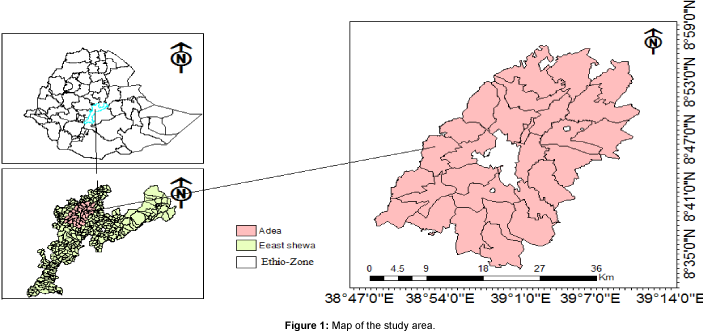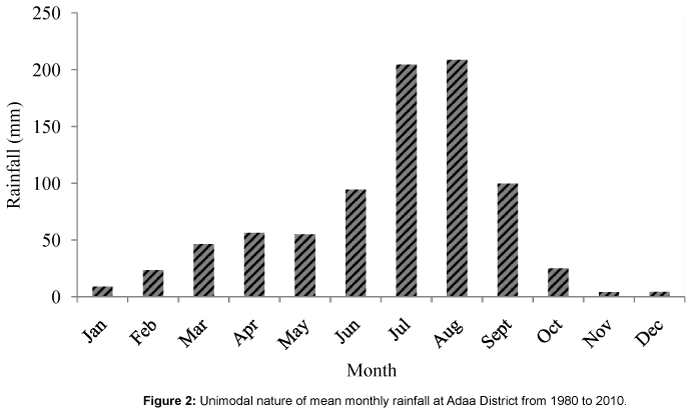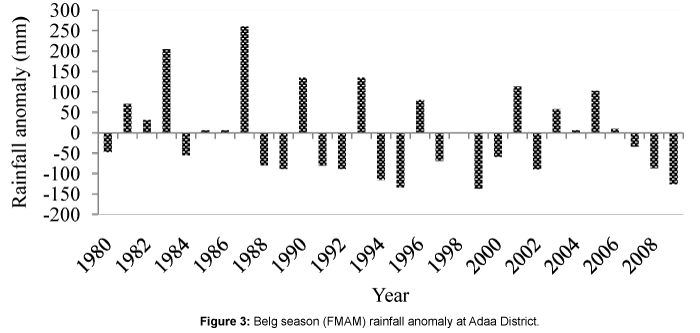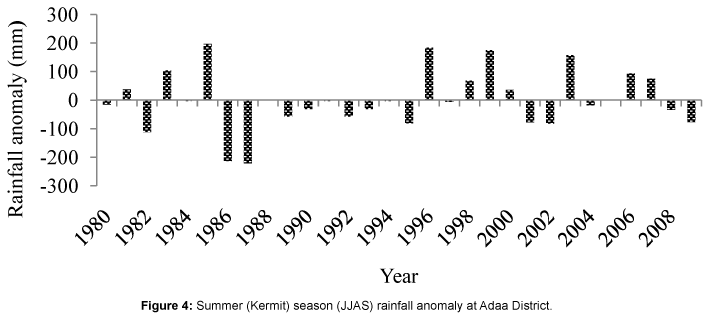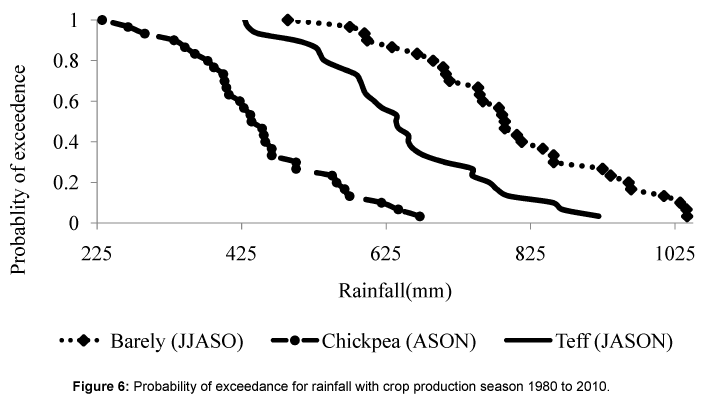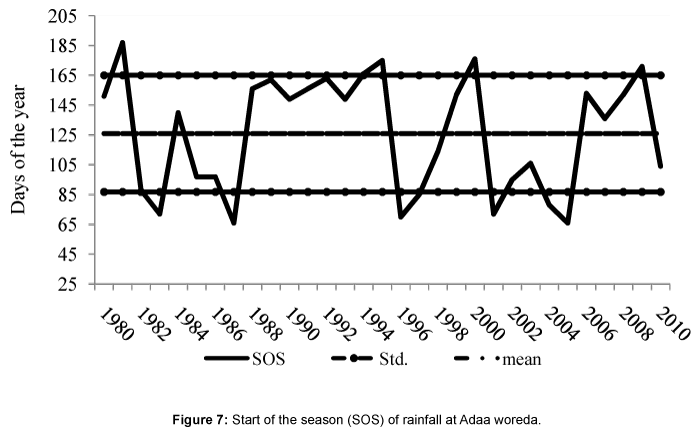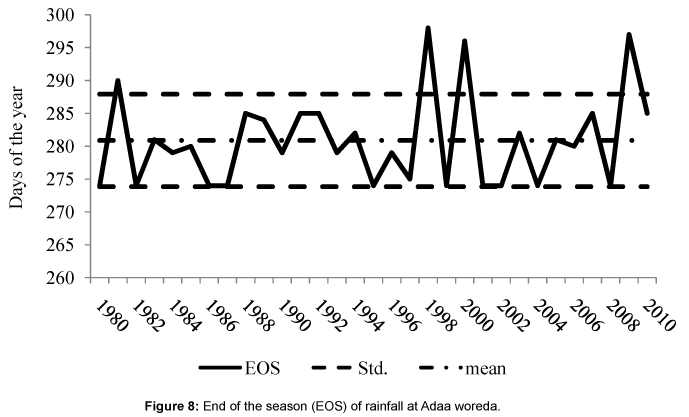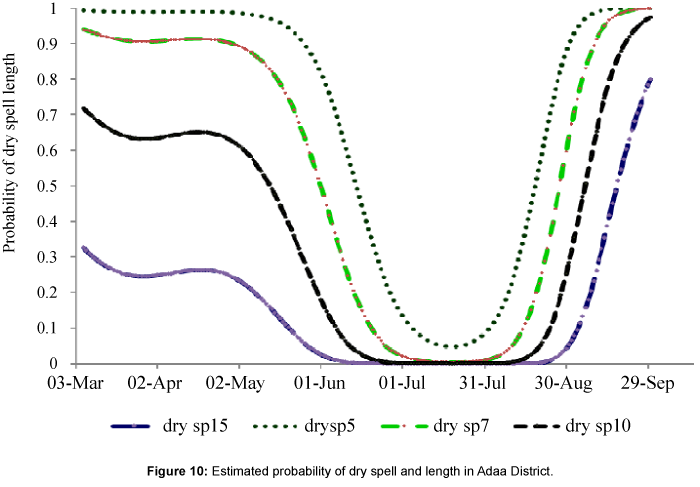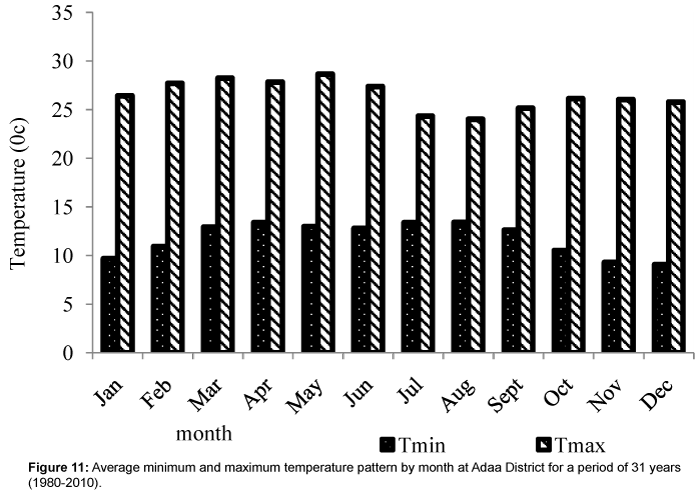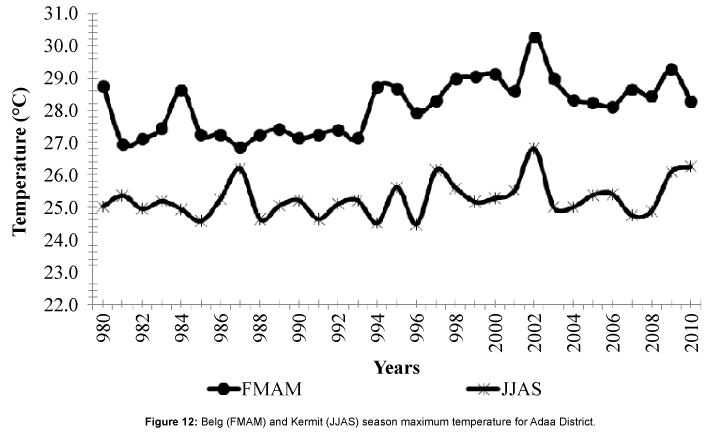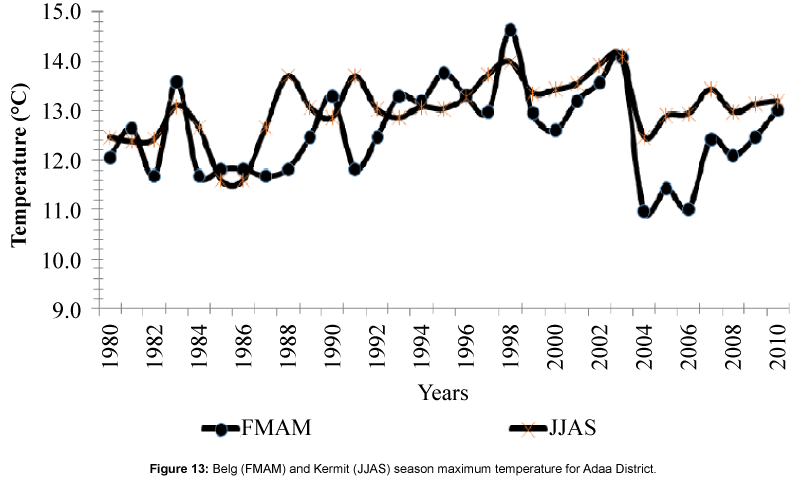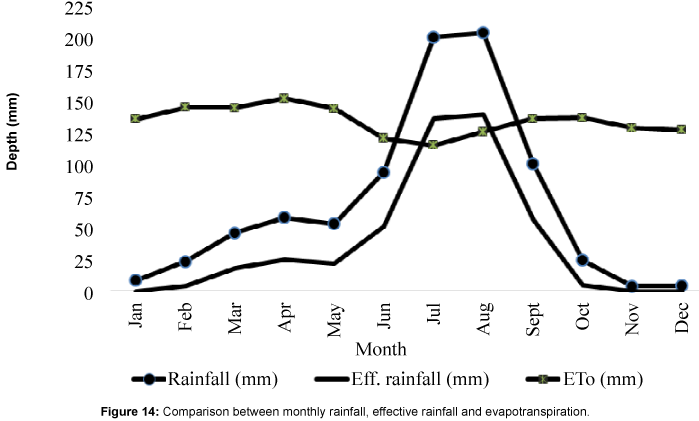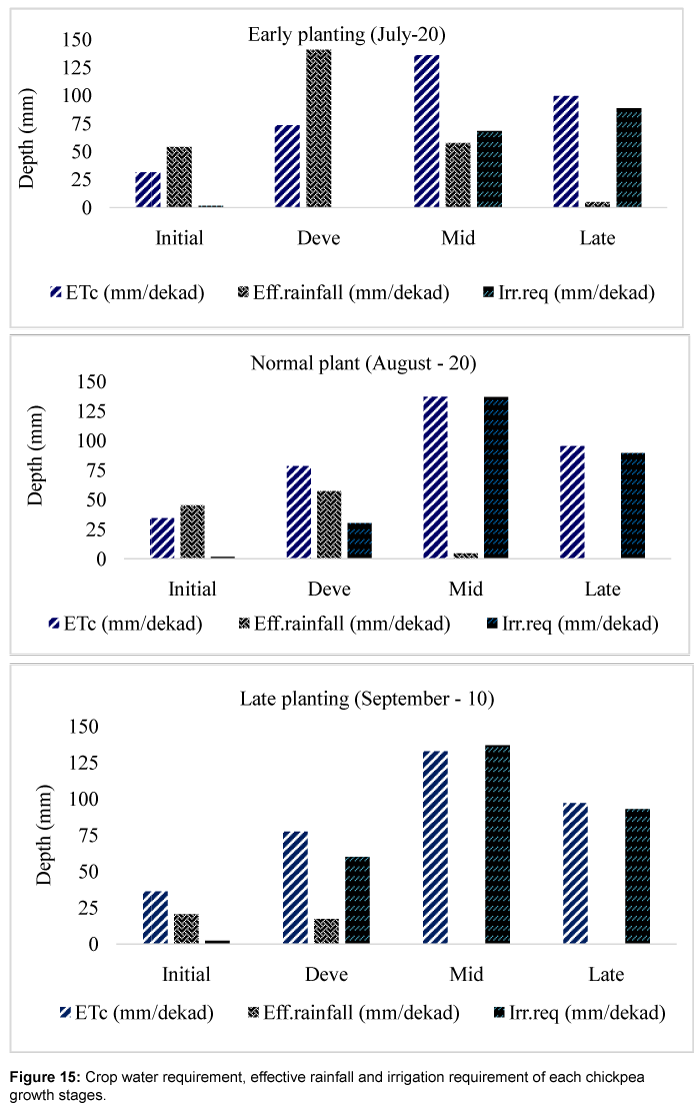Research Article Open Access
Analyzing the Impacts of on Onset, Length of Growing Period and Dry Spell Length on Chickpea Production in Adaa District (East Showa Zone) of Ethiopia
Mengesha Urgaya Lemma*, Araya Alemie, Solomon Habtu and Chere Lemma
Mekelle University College of Dry land Agriculture and Natural Resources, Adama, Orimia, Ethiopia
- Corresponding Author:
- Mengesha UL
Mekelle University College of Dry land
Agriculture and Natural Resources
Adama, Orimia, Ethiopia
Tel no: +251911988727, +251910737815
E-mail: mengeshalemma@yahoo.com
Received April 23, 2016; Accepted May 19, 2016; Published May 22, 2016
Citation: Lemma MU, Alemie A, Habtu S, Lemma C (2016) Analyzing the Impacts of on Onset, Length of Growing Period and Dry Spell Length on Chickpea Production in Adaa District (East Showa Zone) of Ethiopia. J Earth Sci Clim Change. 7:349. doi:10.4172/2157-7617.1000349
Copyright: © 2016 Lemma MU, et al. This is an open-access article distributed under the terms of the Creative Commons Attribution License, which permits unrestricted use, distribution, and reproduction in any medium, provided the original author and source are credited.
Visit for more related articles at Journal of Earth Science & Climatic Change
Abstract
Agriculture is essential for Ethiopian economy while the concerns of climate change impact on agriculture in developing countries have been increasing and this impact could influence agriculture production in a variety of ways. Rising in temperature and rainfall fluctuation patterns, including the amount of rainfall could adversely affect the productivity of crops. Among the various crops cultivated in the area chickpea productivity is paramount importance. Hence, the study is aimed at characterizing the climate of the study area and its impact on chickpea production. Accordingly, for the purpose of the study, climate, soil and chickpea experimental data (Arerti variety) were collected from Debrezeit Agricultural Research Center. Whereas Mann-Kendall test and Sen’s slope estimator, INISTAT+v.3.37 and Excel 2013 were used for analyzing rainfall and temperature variability including trends. Cropwat 8.0 was used to compute chickpea water requirement. The analysis results showed that the mean annual minimum and maximum temperature were 110°C and 260°C, respectively. While the mean annual total rainfall was about 830 mm with the growing period ranging from 99 to 215 days. The variability in start of the season for the stations was relatively high as compared to the end of the season. Crop water requirement of chickpea doesn’t vary by planting date in the study area and the total water requirement indicated on ranged between 340.6 mm and 346.7 mm during the growing season. Whereas, the effective rainfall which is the most determinant factor for yield is very variable by planting dates.
Keywords
Chickpea, Climate change, Climate characterization, CROPWAT, CWR
Introduction
In Ethiopia agriculture is the backbone of the economy of the country with the majority of the population engaged in the sector [1]. It provides direct livelihood for about 83% of the population, contributing 45% of the country’s gross domestic product (GDP), 87% of export earnings, and around 73% of the raw material for agro-based industries. The sector is dominated by subsistence farming where more than 95% is a rain-fed and more than 90% of it is owned by smallholder farmers [2]. The main (Meher) season crops such as cereals, pulses, and oil crops are the major stable food crops grown in Ethiopia with area coverage of 78.17%, 15.17% and 6.66% respectively [3]. Of the pulse crops, chickpea is among the major crops with greater gene bank conservation and breeding potential in the country [4], and production potential (5 t/ha) [5]. Despite its best production potential capacity the crop has not been widely utilized in the country due to climate and other constraint factors.
The rising temperature and fluctuating rainfall patterns, including amount of rainfall could adversely affect the productivity of crops [6]. For instance, temperature is one of the most important determinants of crop growth over a range of environments [7]. Thus increase or decrease in temperature may have significant effect on the growth and yield of crops [8]. At the same time, higher temperatures increases evaporation and transpiration which could have on soil water availability and crop yield [9]. The analysis of rainfall records for long periods provides information about, cropping system, rainfall patterns and variability and used for cultivar choice, that can be grown [10]. Furthermore, the amount and temporal distribution of rainfall and other climatic factors during the growing season are critical to crop yields. Poor or excessive rainfall could induce food shortages and famine, as result Ethiopia has suffered from periodical extreme climate events manifested in the form of frequent droughts that occurred in various years (1952, 1959, 1965, 1974, 1983, 1984, 1987, 1990, 1991, 1999, 2000, 2002, and 2011) and Occasional flooding that occurred in various years (1997 and 2006) [10] which affects agriculture production and lower the GDP in Ethiopia [11].
Past experience shows that cli mate change impacts on future agriculture especially in crop production in semi-arid area. Although Ethiopia’s contribution to the global greenhouse gases emission (GHGs) is limited or almost insignificant, Ethiopian agriculture is the most susceptible and vulnerable to cli mate change [12]. This was due to its poor adaptive capacity, its dependency on rain-fed agriculture where irrigated agriculture accounting for less than 1% of the country’s total cultivated land [13]. Thus, analysis of climate change impact on crop is very essential, especially in Adaa District, East Showa Zone, Central Rift Valley of Ethiopia. The area is drought prone and the people have poor adaptive capacity compared to other parts of Ethiopia. The analysis of climate change is particularly important for pulse crops mainly for chickpea, which is very sensitive to high temperature, climate variability and drought stress, especially at flowering and grain filling stages [14]. Thus, the work of this paper set out to characterizing climate of the study area and assesses the adverse effect of climate variability on chickpea production in Adaa District, East Showa Zone, to improve farmers coping mechanisms.
Material and Methods
Description of the study area
The study was conducted in Adaa District around Debrezeit Agricultural Research Centre in Ethiopia. It is located 50 km south from Addis Ababa, capital city of the country, in Oromia National Regional State, East shewa zone. Its geographical location is from 8°2 0’0” to 9°0’0” N latitude and 38°45’0’’ to 39°18’0’’ E longitudes (Figure 1).
Characterization of climate of the study area
The historical daily climate data of the study area such as temperature, rainfall and sunshine hours were collected starting from 1980 to 2010 from National Meteorological Agency (NMA) of Ethiopia and partially from the records obtained from Debrezeit Agricultural Research Center (DARC). Data were captured into Microsoft Excel version 2013 following the days of year entry format. In order to make the series acquiescent to further analyses, the missing data’s were checked using Markov chain simulation model of INSTAT+v3.37 version. The missed values were simulated through weatherman climate software. Then, the climate characterization analyses of the study area were carried out. The INSTAT+ v3.37 software was used to characterize the start and end of rainfall, length of growing period and dry spell. The determination of these rainfall features are main component of the analyses of various climate risks and events in the growing period [15]. Potential planting date was defined as the first occasion with more than 20 mm rainfall in three days after 6th March or 66 DOY (day of the year). First week of March was selected because most farmers in the Adaa District begin to practice land preparation for the coming main cropping season after the selected date, like other, semi-arid central rift valley areas [16]. The onset and end of main season was determined from the rainfallreference evapotranspiration (ETo) relationship. This approach was presented in a comparison of methods to determine the onset of the growing season in northern Nigeria [17]. Start of the season was the first occasion when cumulative 3 days rainfall is greater than or equal to 50% of the cumulative 5 day reference evapotranspiration and with no dry spell of consecutive more than 9 days within the following 21 days. The choice of 50% ETo as the threshold for water availability is based on experimental evidence that crop water stress becomes severe when the available water is below half the crop water demand (0.5 ETo) [18] and hence the minimum required rainfall amount of a particular date of onset should be at least half of the amount of evapotranspiration (ETo) of that particular date.
Moreover, no occurrence of consecutive more than 9 days dry spells in the next 21 days after the defined date of start of the season to create favourable condition that ensure good for land preparation, seed germination and seedling establishment [19]. For end of rainy season (EOS), the criteria are similarly with the start of the season, end of growing season was determined from rainfall reference evapotranspiration relationship. End of growing season was the cessation of rainy season plus the time required to evapotranspire 100 mm of stored soil water [20]. There was humid period, when rainfall exceeds ETo, at Adaa District. So, surplus stored soil water was available to continue the growing season beyond the cessation of the rainy season. The rainy season was assumed to close down after 30th September or 274 DOY (day of the year) when 3 days cumulative rainfall was less than 50% of the 5day cumulative ETo when soil water balance become 0.5 [21]. Length of growing period (LGP) is a main factor in deciding on the maturity of cultivars to be grown in dissimilar rainfall regime. Therefore, LGP was considered as the period from the beginning of planting rain to the cessation of growing season. The length of growing period (LGP) was determined through subtraction of the SOS from the EOS total seasonal rainfall (mm). Therefore, this inducts the potential plant production time.
On the other hand, the dry spells were analyzed to determining distribution of rainfall and the probability of availability of rains during the critical water requirement periods of crop growth in the rains season which is said to be more reliable for chickpea production in the areas. Dry spells were described as periods with 0.85 mm of rainfall or less. Then dry spell length analysis were used the Markov Chain process, 0.85 mm rainfall as critical water requirement periods of crop growth dry spells [22]. Most farmers of the study area practiced chickpea planting in the second decade of August to September first week. Therefore, analysis was carried out for the probability of dry spell longer than at least five, seven, ten and fifteen consecutive days after the last rains days.
Determination of rainfall and temperature trends
Statistical analyses and simple linear regression analysis were performed with excel sheet and INSTAT v3.37 statistical software for estimating an unknown trend. Trends were assessed at 0.01, 0.1 and 0.05 level of significance using the Mann–Kendall trend test and Sen’s slope estimator [23]. A total of monthly, seasonal and annual rainfalls were computed from daily data and trends were determined by using graphs and trend lines. At the same time from daily minimum and maximum temperature data were organized to generate monthly, seasonal and annual means, and trends were determined as in the rainfall above. The positive value indicates an upward trend and a negative value indicates a downward trend per given value or calculated time step.
Estimation of reference evapotranspiration and crop water requirement of chickpea
Cropwat 8.0 software was used to analyze the reference evapotranspiration, effective rainfall and chickpea supplementary irrigation requirement. The potential evapotranspiration was calculated from monthly minimum and maximum temperature data of 31 years using the Cropwat software method (ETO Penman calculated from temperature data). The effective rain was obtained from annual mean monthly rainfall data of the station (Dependable rainfall (FAO/AGLW formula). In addition to this, chickpea crop water requirement was analyzed based on Kc (crop coefficient value) and chickpea growth stage data [24]. Besides, for chickpea crop water requirement calculation the critical depletion factor, yield response factor, plant root and planting height were based on crop water requirement and irrigation scheduling. [25]. Chickpea is mostly grown on stored soil water, its planting date was chosen according to the practice of farmers in Adaa District and the chickpea supplementary irrigation was analyzed for early, normal (planting date usually practice by the farms of the study area) and late planting date.
Results and Discussion
Annual and seasonal rainfall trend at Adaa district
The study area is characterized by unimodal rainfall type which can be seen separately in terms of crop production (Figure 2). The first is the short rainy season, which extends between March to May and locally known as “Belg”. The second is the long rainy season, which extends from June to September (JJAS) and locally known as kiremt. The rainfall distribution during this period annually varies between 587 to 1122.7 mm with a peak rainfall in August in the study area. The amount and distribution of annual and seasonal total rainfall, timing of onset, end dates and length of growing period (LGP) are critical information on historical rainfall changeability over an area.
The seasonal total rainfall ranged from 0 to 138.6 mm in ONDJ, whereas for FMAM ranges from 46.6 to 443.7 mm and 385.1 to 804 mm in JJAS, respectively (Table 1). The CV is much higher for ONDJ (Bega season), then followed by FMAM (Belg season) and least for JJAS kiremt season). There has been high rainfall variability during Bega (ONDJ) season compared to other seasons. On the other hand, the CV is much higher for Belg total seasonal rainfall than kiremt indicating higher chronological variability of the Belg total season rainfall (Table 2). The annual total rainfalls also showed high inter annual variability that ranged from 587.2 mm to 1122.7 mm. The kiremt season rainfall contributes 73.1% of the annual rainfall whereas the Belg season contributes 21.9% of the annual rainfall. The rest 5% of the annual rainfall are received during the Bega season.
| Descriptive statistics | Annual Rainfall (mm) | Total seasonal Rainfall(mm) | ||
|---|---|---|---|---|
| Rainfall | ONDJ | FMAM | JJAS | |
| Minimum | 587.2 | 0 | 46.6 | 385.1 |
| Maximum | 1122.7 | 138.6 | 443.7 | 804 |
| Range | 535.5 | 138.6 | 397.1 | 418.9 |
| Mean | 830.38 | 42.363 | 181.09 | 606.92 |
| Std.deviation | 144.64 | 38.955 | 103.31 | 102.5 |
| Co-eff.of variation | 17.4 | 92 | 57 | 16.9 |
| 25th percentile | 723.65 | 11.475 | 96.35 | 544.6 |
| 50th percentile | 833.55 | 25.4 | 167.1 | 601.95 |
| 75th percentile | 916.68 | 65.075 | 256.38 | 676.95 |
ONDJ = October, November, December, January
FMAM = February, March, April, May
JJAS = June, July, August, September
Table 1: Descriptive statistics of annual and seasonal rainfall at Adaa District.
| Descriptive statistics | Rainfall features (Start, End and Length of growing period) | ||
|---|---|---|---|
| SOS (DOY) | EOS (DOY) | LGP (days) | |
| Minimum | 66 | 274 | 99 |
| Maximum | 187 | 298 | 215 |
| Range | 121 | 24 | 116 |
| Mean | 126.67 | 280.73 | 154.1 |
| Std.deviation | 39.63 | 7.11 | 37.1 |
| Co-eff.of variation | 31.3 | 2.5 | 24.1 |
| 25thpercentile | 87.25 | 274 | 122 |
| 50th percentile | 144.5 | 279.5 | 134.5 |
| 75th percentile | 157.5 | 285 | 187 |
Table 2: Descriptive statistics for start, end and length of growing season at Adaa District for the last 31 years (1980-2010).
The time series analysis of monthly, annual and seasonal mean rainfall total was also done to reveal the general trends of rainfall amounts over the area. The trend line for long term rainfall anomaly analysis shows shortage of Belg (FMAM) rainfall with decline trends for the period from 1980 to 2009 (Figure 3). While the annual and Kermit (JJAS) seasonal total rainfall trends increased for the period from 1980 to 2009 at Adaa District. Regarding the annual rainfall anomaly, 17 years (57%) showed above average rainfall mean record for a long period, while the remaining 13 years (43%) showed below average rainfall amount. Most of the negative anomalies of the annual rainfall (7 years) occur between 1986 and 1996 (Figures 3, 4 and 5) in the study area.
Trends of seasonal monthly rainfall, minimum and maximum mean temperature and Mann–Kendall test result for trends at the study area, positive values of normalized test statistics (Z) indicate an increasing trend and negative Z values indicate decreasing trends. The rainfall trend was not significant in all months of the growing season (JJAS) except in June (p=0.1) which demonstrated an increasing trend with a magnitude of 0.78 mm per year. Even though it was not significant, the August rainfall trend has shown a decreasing trend with a magnitude of 0.33 mm per year (Table 3).
| Time series |
Rainfall trend | Tmin _trend | Tmax_trend | |||||||
|---|---|---|---|---|---|---|---|---|---|---|
| Test Z | Significant | Q | Test Z | Significant | Q | Test Z | Significant | Q | ||
| June | 1.65 | + | 0.784 | 1.80 | + | 0.030 | 1.09 | 0.021 | ||
| July | 0.99 | 1.543 | 1.87 | + | 0.023 | 0.65 | 0.008 | |||
| August | -0.34 | -0.331 | 3.06 | ** | 0.037 | 0.95 | 0.007 | |||
| September | 0.26 | 0.153 | 1.87 | + | 0.028 | 1.99 | * | 0.022 | ||
Notes: Q = Sen’s slope estimator, z = Mann-Kandall trend test
Table 3: Mann-Kendall trend analysis of rainfall (mm) and temperature (°C).
The mean annual rainfall increased at Adaa District in the years 1981, 1983, 1985, 1990, 1993, 1996, 1997, 1998, 1999, 2001, 2003, 2005, 2006 and 2007. In the rest years the annual rainfall showed below normal rainfall (Figure 5). For instance in 1986, 1995 and 2002 seasons a clear confirmation of water stress and droughts in the study area. Mean seasonal rainfall showed a decreasing trend at Adaa District for Belg and (kiremt) seasons in most of years between 1997 and 2009 (Figures 3 and 4).
The probability of getting rainfall 600 mm for Barely production was 90% from June to October (JJASO). At the same time, for Teff production the probability of getting rainfall of 600 mm from July to November (JASON) was 80%, while for chickpea production the probability of getting rainfall 600 mm was less than 10% depending on the planting date of the crop from August to November (ASON) (Figure 6). In all case, the probability of getting higher rainfall is greater for Barely and Teff than chickpea for the last thirty years in the study area (Figure 6).
Generally, understanding, the rainfall amount, distribution, start and end of the season is essential for altering the crop production system, depending on the length of growing period of the crop and its water requirement. Therefore, for the crop planted at the end of the season and short rainfall to satisfy the crop water demand under changing climate depending on the crop type and growth stage, supplementary irrigation is very crucial for getting better yield.
Rainfall features at Adaa district
There is vulnerability and risk of crop production due to weather fluctuations and climate variability. This minimized by defining and understanding the mean onset of rainfall to start sowing and the time of cessation to determine the length of growing period (LGP), there by choosing appropriate type and variety of crops.
The analyzed rainfall long term data from 1980 to 2010 (31 years) is presented in (Table 2). The delayed start of season was occasionally followed by early start of season (SOS). The variability in start of the season over the past 31 years was very high with the early on March 6 observed in years 1983 (72 Day of the year (DOY)), 1987 (66 DOY), 1996 (70 DOY), 2001 (72 DOY) and 2005 (66 DOY) to the latest around July 11th (187 DOY) observed in years 1981 (187 DOY) 1995 (175 DOY), 2000 (176 DOY) and 2009 (171 DOY). The mean start of season was 126 DOY which is nearly in the first week of May with a standard deviation of 39 DOY (Figure 7).
As showed in Table 2, the 25th percentile of SOS is on March 27th (87 DOY) (once in every four years) with the upper percentile on June 10th (157 DOY) (three times out of four years). Therefore planting earlier than April 9 (97 DOY) was possible once every four years.
The maximum (longest) end of season was 298 days of year (DOY) while the minimum (earliest) was 274 DOY which occurred around the end of September (Figure 8). The average end of season was 281 days of year indicating the variability was very low compared to SOS across the past 31 years in the study area, indicated by small standard deviation 7 days with CV 2.5%.
Length of growing period is the time between the SOS and EOS (Table 2). The average growing length period of the study area is 154 days of year; which is the difference between the average SOS (127 DOY) and EOS (281 DOY) (Figure 9). There is a strong relationship between length of the growing period and start of the rain season because the longest growing period not necessarily depends on EOS rather it depends on the SOS. This shows that the study area is characterized by long growing period. Therefore, length of growing period could not be a problem to any crop in Adaa District and hence, what could be the challenge is the occurrence of different dry spell lengths.
The length of the growing season was 122 days occurring once in four year where as 187 DOY occurring only in three out of four years at Adaa District (Table 2). Most of the variability in length of growing period (LGP) was explained by the start of the season (R2 = 0.97) while it was less dependent on the end of the season (R2 = 0.065). This was due to the reason that the end of season in the study area was more or less constant (CV = 2.5%) and hence, LGP becomes dependent on the onset of rainfall (Table 2). That means if the onset date is early the LGP becomes long while the reverse if it starts late. The LGP was strongly correlated with SOS (r = -0.98) whereas weakly correlated with EOS (r = -0.25). Similar results have been pointed by Kassie et al. [26] in Zeway, Ethiopia.
On the other hand, according to Figure 9 there is a great variation in the length of growing period in the study area. Therefore, early onset date of the season suggested that planting long cycle crops whereas if the length of growing period (LGP) is very important for analysing the risk level of the season and for considering different adaption option in the study area.
Length of growing period LGP is describing the period during which crop growth is not affected by climatic constraints, i.e. the period of the year when water availability allows crop growth in which rainfall exceeds levels of evapotranspiration and when the temperature is not limiting crop growth is the most useful for agricultural production. Chickpea is sensitive to water logging [27]. For the reason that, in Ethiopia this crop is planted on conserved soil moisture starting from the second decade of August to first week of September, at which time the water logging problem has recede and drought stress is about to set in. On the other hand chickpea requires 100 days (length of growing period) starting from initial too late development stage [24]. The season starts from March 6 (66 DOY) and ends ahead of 30th September. However, using the onset and cessation of rainfall criteria’s, it was difficult to capture the length of growing period for chickpea, as it is mainly sown at the end of the growing season. Hence, as an alternative, crop water requirement of the chickpea was determined for each growth stage and then estimated the likely impact of soil moisture stress.
Probability of dry spell in Adaa district
Most legume crops are sensitive to drought at a particular growth stage. Estimation of risk of dry spells over the growing period can help for adjusting planting time so that the sensitive period of the crop could be synchronized with the water availability period [28]. These give insight into the risk related to dry spell lengths during the entire growing season. In addition, the reason behind including the dry spell length conditions into the later month of the growing season is to provide a complete picture of how the dry spell length of various magnitudes are distributed during the entire gr owing season and to examine the associated risk at the site. The overall risk of dry spells from the beginning of March (DOY 66) to end of September (DOY 274) in Adaa District over the 30 years period considering chance of occurrence exceeding 5, 7, 10 or 15 days are showed in (Figure 10).
The maximum unconditional risk of dry spells with length of more than 5, 7, 10, and 15 days at the beginning of March were 99%, 94%, 70% and 30%, respectively whereas the corresponding dry spell length for mid of April were 99%, 91%, 65% and 26% respectively. The probability of dry spells of 5, 7 and 10 days decreased gradually starting from June 21st until the peak rainy period during July and August. The probability of occurrence of short dry spell days is higher than the prolonged dry spells (Figure 10). The probability of occurrence of five days dry spell is the highest, followed by seven and ten dry spells in the growing season. Despite the highest probability of occurrence, its consequence on crop yield may be negligible compared to the longer dry spells.
The probability of 10 and 15 days dry spells occurrence become less than 10% from mid-June to end of August. The occurrence dry spell probability of 5, 7, 10 and 15 were rose from first week September to end of September and during this period chickpea is the dominant crop left in the field based on the local practice in the study area. The probability of 5 and 7 days dry spells were greater than 50% starting from mid-August to the begging of September which is a time that most people in the study area usually sow chickpea. Similarly, the probability of 10 and 15 days dry spells were greater than 50% starting from the first week of September as shown in Figure 11. The occurrences of dry spell length and its consequence increase in evapotranspiration as well as loss of soil moisture. As a result the chickpea crop water requirement increased and supplementary irrigation will require. Moreover, starting from September 29 the probability of longer dry spells increased rapidly, which indicates the seriousness of drought immediately after the cessation of rainfall at Adaa District.
Therefore, farmers who have access to supplementary irrigation could cope up with risks of longer dry spells [29]. If a farmer cannot decide to cop up with risks of 10 to 15 longer dry spells after a potential planting date (called risk averse), he/she has to wait until all dry spells probabilities attains minimum values. There is also the probability of evapotranspiration which become increasing and the probability of moisture stress to crop could be very high. As indicated by Kindie and Walker [24], dry spell analyses are important for farm level agricultural decisions like choice of crop or variety and crop management practices. Hence, it is a key indicator for choosing adaptation option depending on the length of growing period and probability of dry spell length. It is important for chickpea cultivator farmers to know the dry spell length from start of the season to end of the season to decide an appropriate cultivar and planting date. During chickpea flowering and pod setting usually chickpea growers face shortage of moisture in the study area. So getting advisory services on dry spell length and end of the rain season is very crucial, especially for the farmers, who have no access to supplementary irrigation. Deep black soils could support a crop through longer dry spells of 15 and 20 days, whereas sand soils could support only through breaks of 7 to 10 days [30]. These necessitate farmers and/ or planners at Adaa District to design water conservation practices and/ or adoption of early maturing or drought tolerant crops/varieties.
Minimum and maximum temperature trend at Adaa district
The observed historical data shows that the minimum temperature is below 9.1°C during October to January months which represent a relatively cold period. The minimum temperature values (>10.0°C) and the annual average minimum temperature (13.01°C) are observed from March to June, whereas the maximum temperature reaches 27.4°C during January to May (Figure 11). Generally there is variation of both minimum and maximum temperature in the study area throughout the year.
According to the Mann-Kendall trend test, the maximum temperature revealed an increasing trend in the kiremt season (JJAS), however, neither of them was significant except in September (p=0.05). In this month, the maximum temperature has slightly increased. Besides, the minimum temperature was increased in all months of the kiremt season at p=0.1. Especially the temperature in August was significant at p=0.01 (Table 3).
Seasonal maximum and minimum temperature trend
The seasonal maximum temperature of Belg season varies between 27.71°C to 28.66°C. Whereas in the year 2003 the Belg seasonal maximum temperature increases up to 30°C and it decreases slightly (Figure 12). As a result, the variation of temperature has its own impact on agricultural land preparation and crop production.
According to Figure 12, above, Kermit (JJAS) seasonal maximum temperature varied between 24.03°C to 27.39°C for the last 31 years. Consequently this indicated that high evapotranspiration in the area, which results shortage of moisture stress for crop growth and development, which is not suitable for chickpea production. For instance, drought may cause complete crop failure or reduction in biomass and yield [31]. On the other hand, biotic stresses which lead to yield reduction and instability are such as Ascochyta blight, Rhizoctonia root rot, Fusarium wilt, white mold, bacterial blight and certain viruses were possible disease problems in chickpea production occurred as result of temperature and rainfall variation [32]. Starting from 1980 to 2010 the minimum temperature varied between 10.93°C and 13.38°C. The Kermit season showed in Figure 14, that there was slight variation on Kermit (JJAS) seasonal minimum temperature between 12.62°C to 13.4°C in the production area with an increasing trend per year with minimum values of variation (Figure 13).
Rainfall, effective rainfall and reference evapotranspiration
Mean monthly evapotranspiration rate of Adaa District ranges between 116.4 to 154.2 mm/month. The lower monthly evapotranspiration was occurred in the months of June (122.1 mm), July (116.4 mm) and August (127.5 mm). During this time, the annual mean monthly rainfall varies between 95 mm to 206.3 mm, whereas during lower evapotranspiration the total rainfall of (JJA) was 504.2 mm for the reason that ETo were very low in Adaa District. The monthly evapotranspiration of October, November, December, January and February was similar. On the other hand, the reference evapotranspiration was higher in April (154.2 mm) than the rest month of the year (Figure 14). The assessment shows that evapotranspiration is higher in the dry months, is the same as the high temperature observed in these months. Even though there is high moisture in the wet months; the evapotranspiration was very low due to the effect of cloud on the incoming solar radiation. Chickpea is commonly sown at the end of growing season of many crops and hence, this makes chickpea vulnerable to drought stress.
Crop water requirement, effective rainfall and irrigation requirement
The comparison of crop water requirement, effective rainfall and Irrigation requirement of chickpea are presented in Figure 15.
The crop water requirement of chickpea doesn’t vary by plantation date (almost the same). In the study area, the total water requirement indicated on Table 4 ranges between 340.6 mm and 346.7 mm during the growing season. Effective rain, which is the most determinant factor for yield was very variable by planting dates. Considering July planting date, the effective rainfall was 257.5 mm; however, if the planting date is shifted to August, the effective rainfall was decreased by 42% compared to July planting. The effective rain was very low (38 mm) in September planting date which even hinders the growth of chickpea in the area, unless supported by irrigation.
| Depth (mm) | Planting date | ||
|---|---|---|---|
| Early planting (20th-Jul) |
Normal Planting (20th-Aug) |
Late planting (10th-Sep) |
|
| ETc | 340.6 | 346.4 | 343.8 |
| Eff.Rain | 257.5 | 108.2 | 38 |
| Irr.Req. | 158.4 | 258.9 | 292.7 |
Table 4: Growing period chickpea crop water requirement (ETc), effective rainfall (Eff. Rain) of the season and supplemented irrigation requirement (Irr. Req.)
The difference between the crop water requirement and effective rain demonstrates that chickpeaneeds supplementary irrigation with existing cultural practices of farmers. However, the amount of irrigation that needs to be supplemented depends on the planting dates. Planting on September, August and July needs about 292.7 mm, 258.9 mm and 158.4 mm supplementary irrigation respectively (Table 4). The water requirement of crops varies by their growth stages. Hence, what matters for yield may not be the total amount of rainfall in the growing period, but the distribution of the rainfall throughout the critical growth stages of chickpea production?
The most critical growth stages of most crops including chickpea are the mid and development growth stages (flowering and filling seeds stages) [10]. About 40% of the total crop water requirement was used in the mid growth stage which reveals sensitivity of the crop to water stress during this phase. Therefore, if the crop water requirement is not fulfilled in the mid growth stage there will be more likely to decrease yield. The development stage holds about 22.5% of the water required during the growing period of chickpea and hence, it is the second water stress sensitive growth stage of the crop. The remaining initial and late growth stages are less sensitive to moisture stress. In August and September planting dates, the effective rain was very small (almost none) in the mid growth stage (Figure 15). However, in the development stage the effective rain of August planting (57.5 mm) was higher than September planting (17.3 mm) and therefore, this could be the reason why planting in August gives better yield than planting on September. To the contrary, the effective rain was better in all growth stages of the crop in the early planting (July 20th) and hence, provides better yield with less supplementary irrigation (Figure 15).
Generally, this analysis indicates that planting date was very important in fulfilment of the crop water requirements of the critical crop growth stages. As both the normal and late planting dates extend the length of growing period (particularly the mid and development stages) to more dry periods, early planting was found preferable in providing a reasonable yield of chickpeas. However, as chickpea is sensitive to water logging (depends on soil type), increasing the soil water percolation capacity, practicing proper drainage (like raised bed) could reduce the negative impact. Therefore, released water depending on the slop of the land through drainage can be collected in a pond so that it will be used later in the moisture stressed growth stages of chickpea.
Conclusion
As a final point, the historical long term climate data analyzed from 1980 to 2010 indicates that there was variability in rainfall features like start of season (SOS), end of season (EOS) and Length of growing period (LGP) for the study area. The average growing length of the study area is 154 days of year. There is a strong relationship between length of the growing period and start of the rain season. The 5, 7, 10 and 15 days dry spell probability occurrence rise from mid-August to end of September when chickpea is dominantly cover the field based on the local practice in the study area. The mean annual rainfall varied between 587.2 mm to 1122.7 mm but the rainfall trend was not significant in all months of the growing season (JJAS) except in June. On the other hand, the annual average minimum and maximum temperature were 13.01°C and 24.6°C respectively. Even if the water requirement of crops varied by the growth stages. The most critical growth stages of chickpea are the mid and development growth stage, which 62.5% of the total crop water requirement was used in the mid growth stage, while the remaining initial and late growth stages are less sensitive to moisture stress. Moreover, this analysis indicated that planting date was very vital in fulfilment of the chickpea crop water requirements during its critical crop growth stages.
References
- Kidane G, Abebe T, Degefie T (2011) Estimating crop water use and simulating yield reduction for maize and sorghum in Adama and Miesso districts using the Cropwat Model.
- Araya NS (2011) Weather insurance for farmers experience from Ethiopia. Paper presented at the IFAD Conference on New Directions for Smallholder Agriculture practices. 24-25 January, 2011.
- CSA (2013) Agricultural sample survey report volume - I on area and production of major crops - The Federal Democratic Republic of Ethiopia Central statistical Agency, Addis Ababa.
- Gowda CLL, Upadhyaya, HD (2005) Strategy for conservation and enhanced use of crop genetic resources. In: Proceedings of 13th International Genetic Resources Workshop on Rice Genome and Plant Genetic Resources, 22-23 August 2005, Tsukuba, Japan.
- Mzezewa J, Gwata ET (2012) The nature of rainfall at a typical semi-arid tropical ecotope in Southern Africa and options for sustainable crop production. In: The nature of rainfall at a typical-semi-arid tropical ecotope in southern-Africa and options crop-production technologies Southern Africa: 307-787.
- Berger J, Turner N (2007) Chickpea breeding and management. The ecology of chickpea In: Yadav SS, Sharma B (eds.) CAB International, Wallingford, UK,47-71.
- Summerfield RJ (1990) Adaption of chickpea to agro climatic constraints. In Proceedings of the Second International Workshop on Chickpea Improvement. HA van Rheenen, MC Saxena(eds.), ICRISAT Center ICRISAT Publishing,Hyderabad,India: 50–61.
- Basu PS, Ali M, Chaturvedi SK (2009) Terminal heat stress adversely affects chickpea productivity in Northern India- Strategies to improve thermo tolerance in the crop under climate change.ISPRS pp.189-193.
- Clinen P, William R (2007) Global warming and agriculture. In: Impact estimates by country center forglobal development. Peterson Institute for International Economics, Washington.
- NAPA (2007) Climate change, National Adaptation Programme of Action (NAPA) of Ethiopia. The Federal Democratic Republic of Ethiopia Ministry of Water Resources, National Meteorological Agency.
- James KAB (2006) Climate change and South African agriculture. Centre for Environmental Economics and Policy in Africa, CEEPA.
- Marius K (2009) Climate risks and development projects assessment report for a community level project in Guduru, Oromiya, Ethiopia.
- Difalco S, Yesuf M, Kohlin G, Ringler C (2011) Estimating the impact of climate change on Agriculture in Low-Income Countries: Household Level Evidence from the Nile Basin, Ethiopia.Environmental and Resource Economics 52:457-478.
- Devasirvatham V (2012) The basis of chickpea heat tolerance under semi-arid environments. In Crop & Pasture Science. CSIRO publishing.
- Badini O, Dioni L (2001) Application of rainfall analysis, biophysical management and GIS to agro climatic decision support in Madiama Commune, Mali (West Africa). Paper presented to the SANREM CRSP Research Scientific Synthesis Conference. Athens, GA, 28-30 November 2001, Athens.
- Reddy MS, Kidane G (1993) Dry land farming research in Ethiopia: Review of the past and thrust in the future. Institute of Agricultural Research. Addis Ababa Ethiopia.
- Ati OF, Stigter CJ, Olandipo EO (2002) A comparison of methods to determine the onset of the growing season in northern Nigeria. Int J Clim 22: 732-742.
- Dorenboos J, Kassam AH (1979) Crop yield response to water. FAO Irrigation and Drainage Paper No 33 FAO, Rome.
- Stern R, Rijks D, Dale I, Knock J (2006) INSTAT Climate Guide. Statistical Service Center. University of Reading UK.
- Kassam, AH, Kowal JM, Sarrof S (1978) Report on the Agro Ecology Zones - Project Methodology and Results for AFRMA, World Soll Resources Report 40: Food and Agricultural Organization of the United Nations, Rome, Italy.
- Girma M, Fikadu G, Gizachew L (2011) The potential impacts of climate change maize farming system complex in Ethiopia: Towards retrofitting adaptation and mitigation options.In:Proceedings of the 3rd National Maize Workshop of Ethiopia, Addis Ababa, Ethiopia.
- Meinke H, Stone R (2005) Seasonal and inter-annual climate forecasting, the new tool increasing preparedness to climate variability and change in agricultural planning and operations. Increasing Climate Variability and Change pp 221-253.
- Salmi T, AnuMaatt PA, Ruoho-Airola T, Amnell T (2002) Detecting trends of annual values of atmospheric pollutants by the Mann-Kendall test and Sen’s slope estimates the excel template application MAKESENS.
- Kindie T, Walker S (2004) Matching of crop and environment for optimal water use. The case of Ethiopia. Physics and chemistry of the Earth. 29:1061-1067.
- Andreas PS, Keren, F (2002) Crop water requirement and irrigation scheduling.Irrigation manual module 4 Water Resources Development and management officers FAO sub. Regional office for east and South Africa.
- Kassie BT, RötterRP, Hengsdijk H, Asseng S, Van Ittersum MK et al. (2012) Climate variability and change in the Central Rift Valley of Ethiopia: Challenges for rain fed crop production. J AgriSci152:58-74.
- Haile A (2010) Chickpea production, supply, demand and marketing issues in Ethiopia. (ECE Authority).
- Kindie T (2004) Field comparison of resource utilization and productivity of three grain legume species under water stress. Harames University.
- Girma M (2005) Using seasonal climate outlook to advice on sorghum production in the central rift valley of Ethiopia.
- Feyera, M. (2013) Evaluating risks associated with dry soil planting of sorghum [Sorghum bicolor (l.) moench] and maize (Zea mays) at different depths in less predictable onset of rain in the Central Rift Valley, Ethiopia. A thesis submitted to school of graduate studies of Haramaya University, Haramaya University.
- Serraj R, Bidinger FR, Chauhan YS, Seetharama N, Nigam SN(2003) Management of drought in ICRISAT cereal and legume mandate crops.
- Suresh P, Sharma M (2011) Climate change and changing scenario of plant diseases in semi arid tropics Plant Pathology in India: 128-131.
Relevant Topics
- Atmosphere
- Atmospheric Chemistry
- Atmospheric inversions
- Biosphere
- Chemical Oceanography
- Climate Modeling
- Crystallography
- Disaster Science
- Earth Science
- Ecology
- Environmental Degradation
- Gemology
- Geochemistry
- Geochronology
- Geomicrobiology
- Geomorphology
- Geosciences
- Geostatistics
- Glaciology
- Microplastic Pollution
- Mineralogy
- Soil Erosion and Land Degradation
Recommended Journals
Article Tools
Article Usage
- Total views: 13243
- [From(publication date):
May-2016 - Nov 21, 2024] - Breakdown by view type
- HTML page views : 12087
- PDF downloads : 1156

